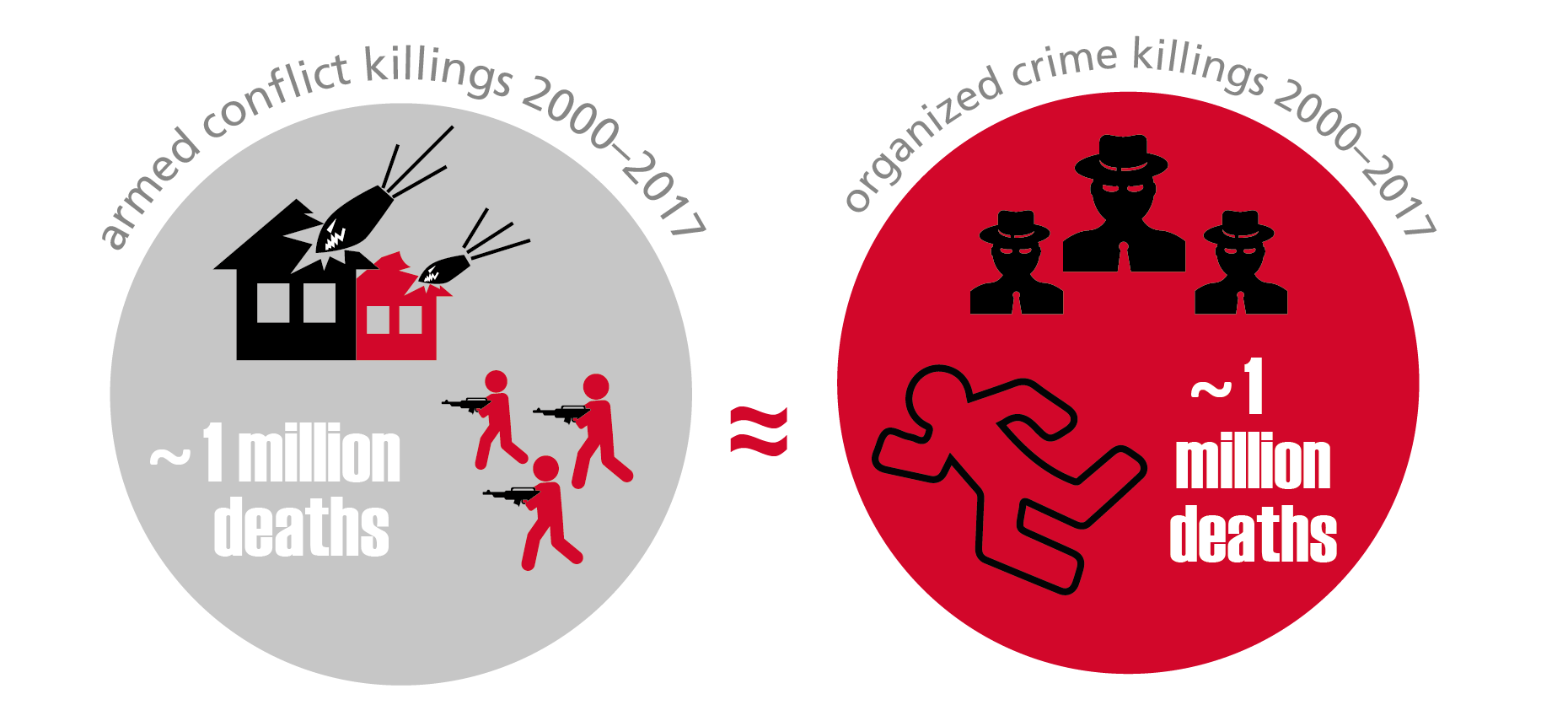Since the publication of the previous edition in 2014, the Global Study on Homicide has been expanded into a special six-booklet format, five of which are dedicated to thematic areas relevant to the study of the ultimate crime.

464,000 people estimated to have been victims of intentional homicide in 2017
An average global homicide rate of 6.1 victims per 100,000 population was estimated in 2017
About 90 per cent of all homicides recorded worldwide were committed by male perpetrators
Men make up almost 80 per cent of all homicide victims recorded worldwide




Crime-related homicide: homicide committed in the context of organized crime and gang violence and homicide committed while perpetrating other criminal acts such as robbery and sexual assault.
Organized crime kills as many people as all armed conflicts combined

Interpersonal homicide: homicide that occurs in the context of interpersonal conflict.
The vast majority of women and girls are killed by intimate partners or other family members

Sociopolitical homicide: homicide linked to social discrimination, political agendas, civil unrest and broader sociopolitical motives, such as killing of human rights defenders, humanitarian aid workers or journalists.
Number of journalists killed, by region, 2012–2016
Homicide Data
This booklet constitutes the second part of the Global Study on Homicide 2019. It provides an overview of intentional homicide counts, rates and trends. Starting at the global level, the analysis turns to regional, subregional and national trends before the focus shifts to the subnational picture of homicide in selected locations where such data are available and patterns can be identified. Urban homicide patterns and urban homicide trends are examined as are the demographics of homicide victims and the sex of homicide perpetrators. The booklet ends with an overview of the criminal justice response to homicide. In-depth contributions by external experts feature throughout the booklet.
Constituting the third part of the Global Study on Homicide 2019, this booklet provides an overview of the drivers of homicide and looks at the different typologies and mechanisms of homicide perpetration. The drivers of homicide are manifold and have to do with a number of factors: socioeconomic and environmental conditions, governance and the rule of law, political stability, demographics, and cultural stereotypes (particularly in relation to gender roles). Homicidal violence is also influenced by the availability of mechanisms such as firearms or sharp objects, and by the use and trafficking of psychoactive substances. The links between homicide and socioeconomic and environmental factors, along with the ways in which these factors may drive homicide or contribute to its containment, are analysed in booklet 4, which focuses on the interactions between homicide and development.
Constituting the fourth part of the Global Study on Homicide 2019, this booklet starts by examining the relationship between homicidal violence and level of development with reference to the Sustainable Development Goals. A macroanalysis of the extent to which homicide rates can be explained by national levels of development is then presented. The analysis is based on a set of models that incorporate the latest available homicide data and were designed to take into account the social and economic factors most strongly correlated with homicide rates across countries. Comparing the homicide rate predicted on the basis of a country's level of development with the actual homicide rate reported by that country helps to clarify how effective development policies can be instrumental in reducing homicidal violence.
Constituting the fifth part of the Global Study on Homicide 2019,this booklet gives an overview of the scope of gender-related killing of women and girls. It provides in-depth analysis of killings perpetrated within the family sphere and examines forms of gender-related killings perpetrated outside the family sphere, such as the killing of women in conflict and the killing of female sex workers. The booklet explores the scale of intimate partner/family-related killings of women and girls, and describes different forms of gender-related killings of women. It also looks at the characteristics of the perpetrators of intimate partner killings, the link between lethal and non-lethal violence against women, and the criminal justice response.
Violence against children is a multidimensional phenomenon that is often underreported; it can take many forms and is influenced by a wide range of factors, such as the personal characteristics of the victim and perpetrator and their cultural and physical environments. Such violence remains hidden in many instances because children are often afraid to report acts of aggression, and also because reporting mechanisms tend to be inaccessible or even non-existent. Children may also keep silent about the violence they suffer when it is perpetrated by parents and other family members, or by another figure of authority such as an employer, community leader or police officer. Lethal violence against children can occur in a continuum of violence, representing the culmination of various forms of violence that children may be subjected to in different settings. One of the targets of Sustainable Development Goal 16 on peace, justice and strong institutions is to "end abuse, exploitation, trafficking and all forms of violence against and torture of children".